Written by: Karel Minor, Humane Pennsylvania CEO & President
It’s extremely satisfying to see the large fish foundations and animal welfare organizations embracing and championing access to veterinary care. Humane PA has embraced and proselytized access to veterinary care as a core of our mission for nearly 20 years. And yes, to paraphrase Cake, I have the t-shirt to prove I was there and I heard of it first. I recognize the importance of this concept in helping animals, people, and entire communities. All are welcome to this party — the more, the merrier!
But there is a problem. The term “access to care” means something different to different people and organizations. Some people think it means free or reduced care, or certain types of care, or every kind of care, or only charitable or non-profit care. In fact, the same term can encompass any and/or all of these things.
At Humane Pennsylvania, it has been and meant many different things since we first started offering expanded veterinary services to the community in 2005. In the decades before that, when we had the regularly offered low-cost sterilization program in the area, it was something entirely different.
So to combat misunderstandings around what access to care means, Humane PA takes a purpose-driven approach to practice management. When a service, program, or even phrase offers so much opportunity for confusion, the first step is to answer the question: “What is the purpose of what we are doing?”
approach to practice management. When a service, program, or even phrase offers so much opportunity for confusion, the first step is to answer the question: “What is the purpose of what we are doing?”
Seventeen years ago, access to care for HPA (then the Humane Society of Berks County) meant getting access to vet care for our own sheltered animals. It quickly changed to include providing limited vet care access to the community, because they needed it and we had it — at least a little of it. We started with vaccinations. Then some wellness care. Then sick care and additional surgical interventions. Our definition of access to vet care changed as our capacity to deliver it changed.
But we remained in a reactive posture, not a proactive one, for some time. We thought the access we had and could provide to the community could vanish in the blink of an eye. It felt transitory. Smaller shelters like ours didn’t have vet practices — and weren’t supposed to have vet practices. And frankly, we didn’t really know what we were doing in the first couple of years.
Then we started to get into new budget years where we had to plan for the coming year and how we would pay for costs associated with providing access to vet care. We began to realize we could do anything. We could provide anything our shelter animals and our communities needed. The possibilities were there — but we just couldn’t afford to do it. Just like the local for-profit vet can’t.
Sure, we could all give every penny of our own money to the charitable cause of our choice. And in the short term, it would really help the cause. But once the money runs out and we’ve sold our homes, clothes, and vehicles, not only is the charity out of luck, but we no longer have anything left to give.
Out of necessity, purpose rapidly rises to the top of the list of considerations. What are we trying to do? What do we mean when we say access to care? And what can we afford?
I will focus on several important aspects of access to care and purpose-driven vet practice management in future posts. But today, I will suggest that sustainability is the most crucial aspect for any charity or for-profit business, regardless of its purpose.
If 100 people need help each week, choices must be made. Helping all 100 people might take all the resources an organization has and bankrupt it. If the organization collapses after helping 100% of those 100 people, no one gets help the next week or the week after. It is a pyrrhic victory. This is not simply a theoretical situation — the former Humane League of Lancaster County faced that crisis when it overextended its reach and capacity in its first public animal hospital.
those 100 people, no one gets help the next week or the week after. It is a pyrrhic victory. This is not simply a theoretical situation — the former Humane League of Lancaster County faced that crisis when it overextended its reach and capacity in its first public animal hospital.
But if an organization finds a sustainable way to help 25 of those 100 people each week, it can consistently help that smaller number week after week. That’s not universal access to care, but it is sustainable access to care for a portion of the population in need. That’s a victory that lasts.
But now the decisions can get tricky. What if all 100 people don’t have an equal need? What if 50 of those people can pay half the bill and the other 50 people need the entire bill covered? Instead of providing 100% coverage to ensure 25 people get access to care, you could help the 50 people who only need half the help. That’s twice as many people helped each week. But some people still wouldn’t have access.
Humane Pennsylvania went through this exercise and chose to help the greatest number of people and animals. We decided to start with those requiring the least assistance to gain access, not those who needed the most assistance. That was a tough choice to make, but viewed through a purpose-driven lens, it’s the right choice.
The purpose of Humane Pennsylvania’s veterinary services is to help as many animals and people as possible gain access to vet care they otherwise would not be able to access or afford. Helping 10 people who only need $1.00 worth of assistance is 10 times more effective than helping one person who needs $10.00 of aid — and it helps 10 times more animals. Some might not agree with that decision and approach, and that’s their right. But I challenge them to find a practical, real-world way to close the gap starting from the bottom up.
Of course, we didn’t stop there. The financial realities only required us to start there. Identifying our purpose allowed us to find targeted ways to help those we weren’t helping and serve Humane Pennsylvania’s purpose: to stop needless animal suffering and death and build the best communities anywhere to be an animal or animal caretaker.
We couldn’t give free, comprehensive vet care to all. But we could provide free microchip IDs to all and prevent needless deaths of unidentified strays in shelters. So we added that service to our purpose-driven practice model. We could have neighborhood vaccine clinics and prevent parvo and FeLV from killing dogs and cats. So added service to our purpose-driven practice model.
We spoke to clients who were being offered 100% free care, and they told us they wanted the opportunity to give something if they had it. So we created the pay-what-you-can model. If you can pay something, you pay what you can. If you can’t pay, you don’t. This empowers our clients with the ability to choose, and we have more resources to help more people.
We recently identified a service gap we believe we can fill with a veterinary walk-in clinic model. It’s modeled on human urgent care clinics and is groundbreaking and cutting edge in animal welfare. We are developing this new approach in tandem with a handful of other organizations around the nation as we all find a model that serves our purpose and is sustainable.
And sustainable is the secret word for the day. No program, no service, no good intention can survive and fulfill its purpose unless it can be sustained. Humane Pennsylvania, Humane Veterinary Hospitals Reading/Lancaster, and the Healthy Pets Initiative have found sustainable ways to help animals and people who had no access to vet care. And we keep finding new and better ways to fulfill our mission. As a result, tens of thousands of people and animals now get the leg up they need each year and have better health and wellbeing.
I am so excited to share the work we have been a part of pioneering right here in Berks and Lancaster Counties, with all the organizations seeing the value and the urgent need for sustainable, meaningful access to veterinary care.
Karel Minor, CEO & President
Humane Pennsylvania


 Not surprisingly, the greatest risks to pets are found around the home. Plants, foods, human medications, cleaning supplies, and automotive products are responsible for the vast majority of pet poisoning cases reported to veterinarians and poison control centers.
Not surprisingly, the greatest risks to pets are found around the home. Plants, foods, human medications, cleaning supplies, and automotive products are responsible for the vast majority of pet poisoning cases reported to veterinarians and poison control centers.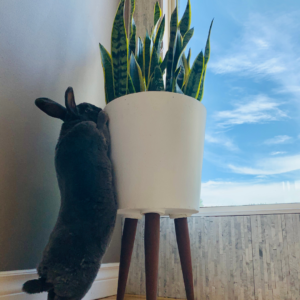 garlic, onions, yeast dough, and any processed foods containing the sweetener Xylitol.
garlic, onions, yeast dough, and any processed foods containing the sweetener Xylitol. In Case of a Pet Poisoning Emergency
In Case of a Pet Poisoning Emergency Rabbits have been in our lives since the 5th century, when these adorable creatures won the hearts of humans and were domesticated to be pets. Did you know rabbits are currently the second-most popular pet, after goldfish? And according to insider.com*, other than cats and dogs, rabbits are one of the most popular pets in the U.S. — second only to goldfish. It’s no wonder these critters get a whole month dedicated to finding their forever homes.
Rabbits have been in our lives since the 5th century, when these adorable creatures won the hearts of humans and were domesticated to be pets. Did you know rabbits are currently the second-most popular pet, after goldfish? And according to insider.com*, other than cats and dogs, rabbits are one of the most popular pets in the U.S. — second only to goldfish. It’s no wonder these critters get a whole month dedicated to finding their forever homes. climb onto or dig in — all are AMAZING in the eyes of a bun. You can teach them anything you can teach a dog: sit, stay, jumping through hoops, jump up, etc. There’s simply no end to what you can fill their little heads with.
climb onto or dig in — all are AMAZING in the eyes of a bun. You can teach them anything you can teach a dog: sit, stay, jumping through hoops, jump up, etc. There’s simply no end to what you can fill their little heads with.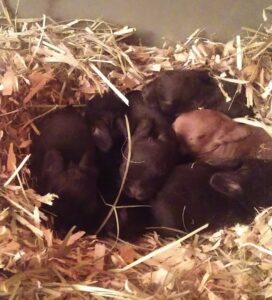 You do have to keep in mind, however, that owning a rabbit (just like any other pet) isn’t always all fun and games. You need to be prepared for the inevitable vet bills, and establishing a relationship with an exotics vet will ease some of your worries if an emergency should one day occur.
You do have to keep in mind, however, that owning a rabbit (just like any other pet) isn’t always all fun and games. You need to be prepared for the inevitable vet bills, and establishing a relationship with an exotics vet will ease some of your worries if an emergency should one day occur. time to shake those muscles loose and take a second swing at this. This time I want to express the enthusiasm, gratitude, and joy my heart and mind feel for all the positive outcomes we’ve experienced this year.
time to shake those muscles loose and take a second swing at this. This time I want to express the enthusiasm, gratitude, and joy my heart and mind feel for all the positive outcomes we’ve experienced this year.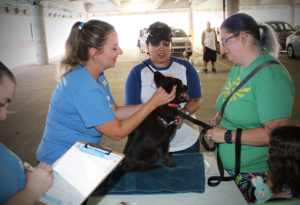 Neighborhood Clinics: COVID made it more challenging, but it didn’t stop us from going into neighborhoods to connect with pets directly and provide critical vaccines, microchip identification, and other vital healthcare services. Our specially trained teams of staff and volunteer veterinarians, technicians, and assistants provided services week in and week out to thousands of people in 2021. We partnered with the Animal Rescue League to share data to allow us to map parvo outbreaks in Reading and then work together at community clinics held at Amanda E. Stout Elementary School. This partnership let us help more than we could have alone, and the data sharing allowed us to deliver that help where it was needed most.
Neighborhood Clinics: COVID made it more challenging, but it didn’t stop us from going into neighborhoods to connect with pets directly and provide critical vaccines, microchip identification, and other vital healthcare services. Our specially trained teams of staff and volunteer veterinarians, technicians, and assistants provided services week in and week out to thousands of people in 2021. We partnered with the Animal Rescue League to share data to allow us to map parvo outbreaks in Reading and then work together at community clinics held at Amanda E. Stout Elementary School. This partnership let us help more than we could have alone, and the data sharing allowed us to deliver that help where it was needed most.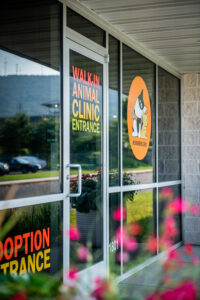
 Berks Humane Scholar Center shelter in 2006, it’s lovely to have it become a reality. Both HVH Reading and Lancaster are American Animal Hospital accredited and open to the public. Our hospitals were the first non-profit hospitals in Pennsylvania to achieve accreditation — and among fewer than 30 in the country. Less than 15% of the 36,000 for-profit vet practices are accredited.
Berks Humane Scholar Center shelter in 2006, it’s lovely to have it become a reality. Both HVH Reading and Lancaster are American Animal Hospital accredited and open to the public. Our hospitals were the first non-profit hospitals in Pennsylvania to achieve accreditation — and among fewer than 30 in the country. Less than 15% of the 36,000 for-profit vet practices are accredited.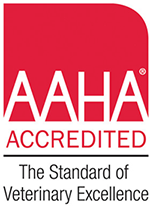 the nation in recognizing the barriers to access to vet care for large portions of our communities and then finding ways to deliver affordable, high-quality care sustainably. I was recently one of only about 50 people nationwide to participate in an ASPCA “Access to Care” Conference, which sought to find ways to expand access and remove barriers to vet care. It’s an exciting effort, and HPA is a recognized national leader and voice in this vital work. If you aren’t already a client of one of our two public hospitals,
the nation in recognizing the barriers to access to vet care for large portions of our communities and then finding ways to deliver affordable, high-quality care sustainably. I was recently one of only about 50 people nationwide to participate in an ASPCA “Access to Care” Conference, which sought to find ways to expand access and remove barriers to vet care. It’s an exciting effort, and HPA is a recognized national leader and voice in this vital work. If you aren’t already a client of one of our two public hospitals,  If you are a veterinarian or a veterinary tech, we’re hiring! You can join a practice that offers all the benefits and support of a “gold-standard” practice, and also lets you help animals and people and practice medicine like a vet — not according to a corporate checklist. You don’t know what you don’t know about Humane Veterinary Hospitals,
If you are a veterinarian or a veterinary tech, we’re hiring! You can join a practice that offers all the benefits and support of a “gold-standard” practice, and also lets you help animals and people and practice medicine like a vet — not according to a corporate checklist. You don’t know what you don’t know about Humane Veterinary Hospitals, 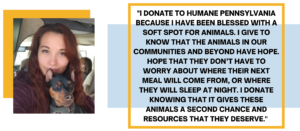
 year later, he was still terrified of humans. He had no potential adopters, and he no longer had a safe outdoor home. He was really miserable — as were his caretakers.
year later, he was still terrified of humans. He had no potential adopters, and he no longer had a safe outdoor home. He was really miserable — as were his caretakers. Returning sterilized cats to areas where other cats live may seem counterintuitive. However, due to the vacuum effect, new cats move into voids created by the removal of existing cats to take advantage of food, water and shelter. On the other hand, the practice of trapping, removing and killing cats often results in increases in free-roaming cat populations.
Returning sterilized cats to areas where other cats live may seem counterintuitive. However, due to the vacuum effect, new cats move into voids created by the removal of existing cats to take advantage of food, water and shelter. On the other hand, the practice of trapping, removing and killing cats often results in increases in free-roaming cat populations.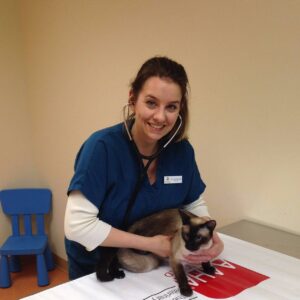 This is your friendly reminder to schedule your annual wellness exam if your kitty hasn’t been to the vet this year. Establishing a relationship with a vet for a wellness visit is essential; it helps ensure that your vet can see your cat should your cat ever have any urgent needs. If your cat is up-to-date with vaccines, a yearly exam is still an important step to make sure your cat remains healthy. A head-to-tail exam for every cat is necessary to assess dental health, monitor body weight, check lumps and bumps, and check lab work to detect early disease in senior cats.
This is your friendly reminder to schedule your annual wellness exam if your kitty hasn’t been to the vet this year. Establishing a relationship with a vet for a wellness visit is essential; it helps ensure that your vet can see your cat should your cat ever have any urgent needs. If your cat is up-to-date with vaccines, a yearly exam is still an important step to make sure your cat remains healthy. A head-to-tail exam for every cat is necessary to assess dental health, monitor body weight, check lumps and bumps, and check lab work to detect early disease in senior cats. o signify that blood and urine tests should be ordered so that vets can screen for organ or endocrine dysfunction. In addition, fecal samples are recommended annually to screen for intestinal parasite eggs.
o signify that blood and urine tests should be ordered so that vets can screen for organ or endocrine dysfunction. In addition, fecal samples are recommended annually to screen for intestinal parasite eggs.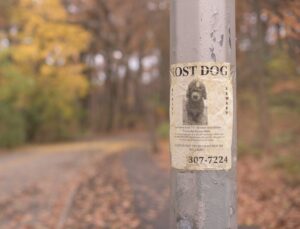 The fear of never seeing them again sets in immediately. Or if they end up hours away – how will someone get in contact with you? What if they’re hurt and need help?
The fear of never seeing them again sets in immediately. Or if they end up hours away – how will someone get in contact with you? What if they’re hurt and need help?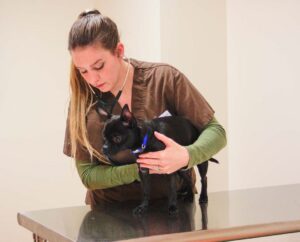
 Remember that dogs grow, lose weight, and gain weight just like people do, so it is important to frequently check how your dog’s collar fits and also that it is in good condition.
Remember that dogs grow, lose weight, and gain weight just like people do, so it is important to frequently check how your dog’s collar fits and also that it is in good condition.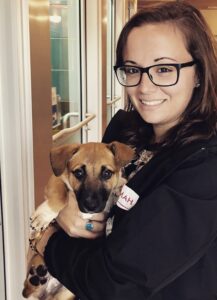 their business partner with us for a fundraiser. It’s so lovely to see people really embrace our mission and have an understanding of what Humane Pennsylvania is all about.
their business partner with us for a fundraiser. It’s so lovely to see people really embrace our mission and have an understanding of what Humane Pennsylvania is all about.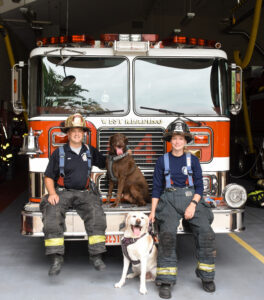 hazard because dogs, cats, mice, bunnies will sometimes chew on them. Unattended lit candles are not only dangerous on their own but can be easily knocked over by pets.
hazard because dogs, cats, mice, bunnies will sometimes chew on them. Unattended lit candles are not only dangerous on their own but can be easily knocked over by pets. A.G.: If you can’t get them out, DO NOT go back in to get them. Let the arriving responders know the last known location and a description of the animal.
A.G.: If you can’t get them out, DO NOT go back in to get them. Let the arriving responders know the last known location and a description of the animal.